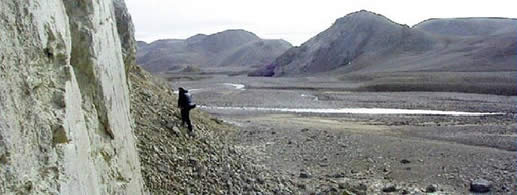Arctic Special - Issue 7, Autumn 2000


|
Robotic Geologists by Bill Clancey In 1972 a geologist, Harrison Schmidt, walked on the moon. His experience enabled him to understand how the hills, valleys, and rocks were related. When unexpected discoveries were made, he used his time wisely and searched for good rock samples to bring back to earth. But people have not walked on Mars yet. Instead, in 1997 we sent a remotely controlled "rover," called Sojourner, to take photographs and make measurements. This data was sent back to earth for scientists to study. With the aid of 3-d photography, our "telescience" experience was almost like being there. Or was it? What could people do if they walked on Mars directly that they could not do by remotely controlling a rover? Well, one big problem is the time delay. Sojourner was programmed to move only 7.5 cm and stop to wait for the next command. Its laser sensor could only "see" 20 cm ahead. This is like not being able to see beyond the tips of your shoes. Scientists had to typically wait 20 minutes for a command to be received on Mars and another 20 minutes to find out what the robot did, and so on. It could take hours just to move Sojourner one meter! A person walking on Mars could see something a kilometer away and go get it. However, sending people to Mars is much more expensive than sending machines, and it is dangerous -- three years is a long time to be away from a hospital. Why do not we just send smarter robots? Could we invent a robot that could decide where to go and what rocks to pick up, just like Harrison Schmidt? Maybe some day this would be possible. But not very soon. Sojourner was not a true robot; it was remotely controlled by people sitting at workstations back on Earth. Sojourner could navigate to go where it was told to go, but it could not recognize rock types like a geologist could; it couldn’t think about how the valley in which it moved was formed by water or wind; it could not reason about how to use its time wisely (before it died in the martian winter). In short, Sojourner could not explore. What do we need to know in order to build a smarter robot? We need to develop a machine that can climb cliffs and go around boulders and crevices, the way a geologist can go to an outcropping on a slippery slope (see picture below of a geologist on Devon Island). We do not know how to build a machine that is as physically coordinated as people. We also need to understand better how human perception, reasoning, and memory work. How do people recognize similarities, form analogies, adapt to new variations, and reason about unexpected situations? We need to understand how people work together, so we can build a robot team that divides up tasks, and uses good judgement in interpreting what we want them to do.
 A geologist looking for interesting features on a steep hill.
So the question is not whether we should send people or robots to Mars. First, we will continue to send machines that scientists control remotely. Eventually machines will become "robotic", able to physically move over difficult terrain, and even "decide" where to go. But almost certainly we will be able to send people safely before such robots exist. Then we will send robots and people, and the real question will be, how can they best work together? |